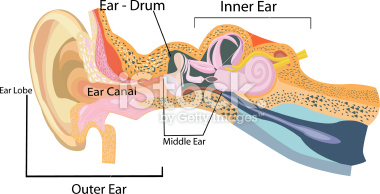 Hearing begins when the outer ear, the visible portion of the ear that is on the outside of the head, channels sound waves down the auditory canal. This tube like passageway is lined with tiny hairs and small glands that produce ear wax.
Hearing begins when the outer ear, the visible portion of the ear that is on the outside of the head, channels sound waves down the auditory canal. This tube like passageway is lined with tiny hairs and small glands that produce ear wax.
The middle ear lies at the end of the auditory canal. It is composed of the ear drum and three small bones known by the layman as the hammer, the anvil and the stirrup. When sound waves hit the ear drum, it vibrates and, in turn, moves the hammer. The hammer moves the anvil, which moves the stirrup which moves the vibrations into the inner ear.
The inner ear consists of the cochlea and the nerve of hearing. It converts sound waves into nerve impulses that travel to the brain via the movement of tiny hair cells. The brain, in turn, allows us to hear…as long as the message it is receiving is not distorted due to problems in the process just described.
